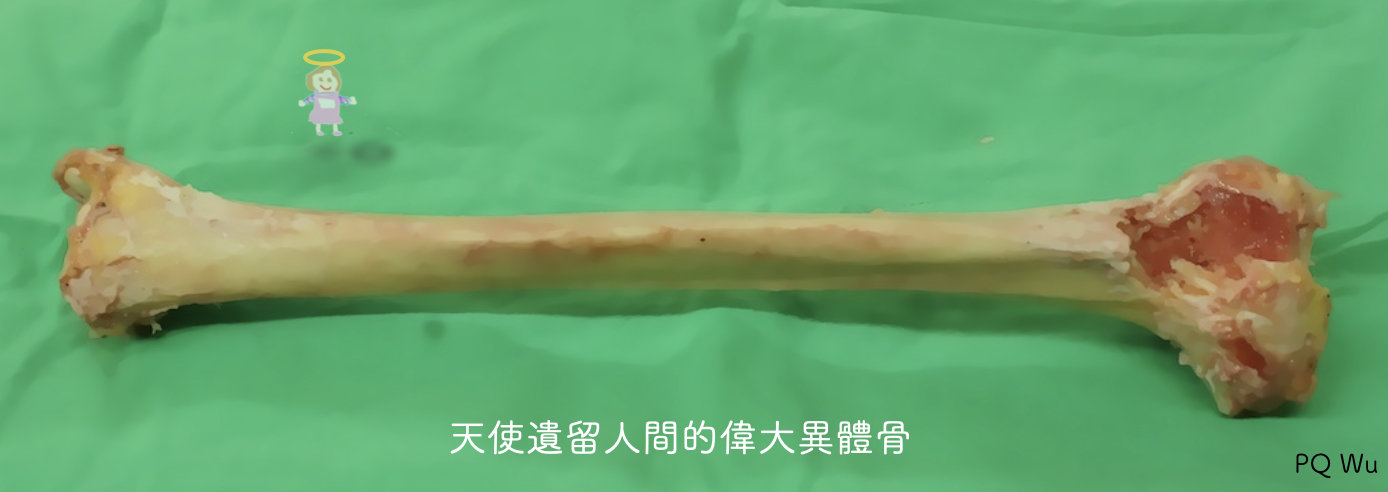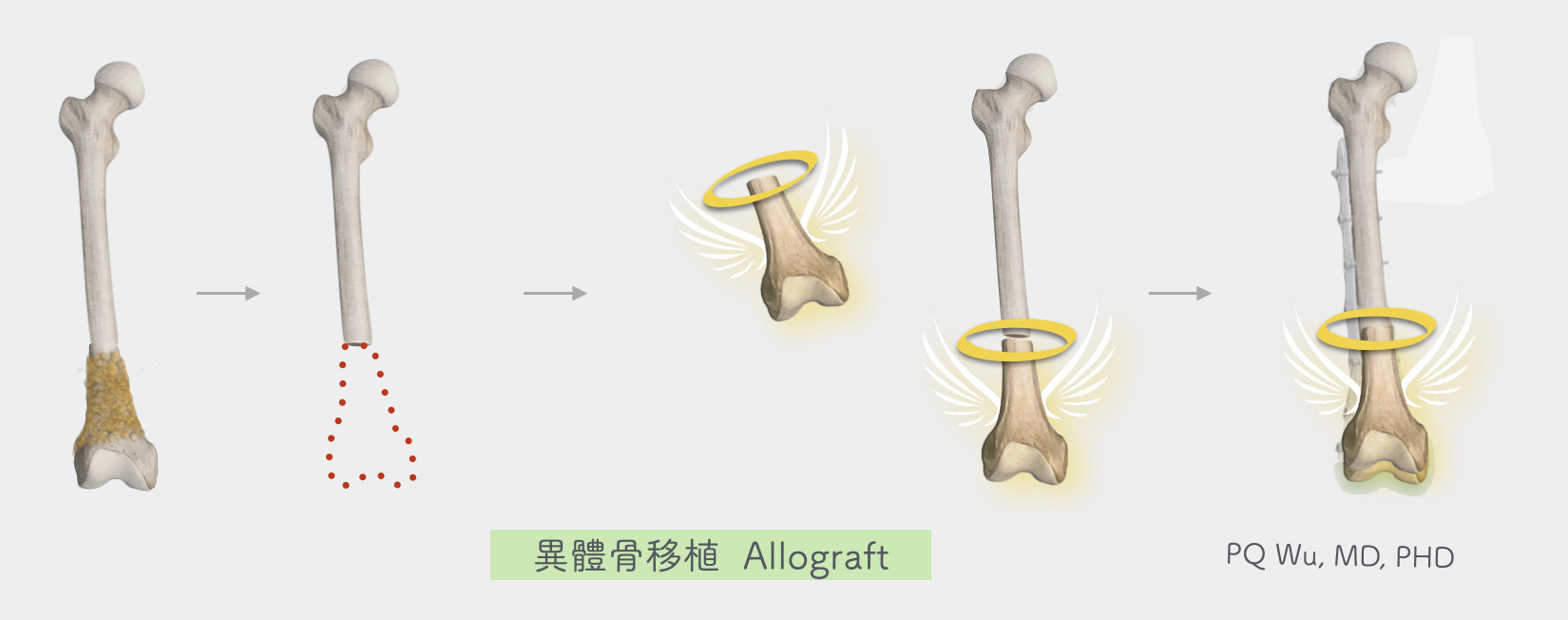First: Biological reconstruction
- allograft
- frozen recycled autograft
- in vitro high-dose irradiated autograft
Second: Tumor prosthesis
artificial metal joints.
Third: Bone prosthesis composite
Allogeneic bone, frozen and radioactive autogenous bone are the main part with an artificial joint being assembled.
Before reading this chapter, please read through the previous section- Biological reconstruction, for prior understanding. Allograft bone transplantation is a kind of biological reconstruction, mainly used to reconstruct bone defects after removing bone tumors. It’s a widespread way for clinical use. As the name implies, 'allograft bone' refers to 'other people's bones, and there are several common sources of allograft bone:
Donations from patients undergoing joint replacement surgery
Some bones must be removed for joint replacement surgery, and these unnecessary bones can be donated to patients in need. Such allogeneic bones are small fragments and irregular in shape.
A patient who passed away donates his/her bones and leaves love behind
Before a patient passes away, he/she decided to donate the whole body, including the cornea and bones. These allogeneic bones are mostly entire bones with complete structure, which can be donated to patients in need.
When we perform biological reconstruction, we will need an entire section of complete skeleton for a proper structural support after transplantation. As mentioned above, the allogeneic bone donated by patients passed away with angel's love could be considered to use for biological reconstruction. The following picture shows the bone used in surgery.

The Skeleton Bank at Taipei Veterans General Hospital is the first institution certified by the Ministry of Health and Welfare in Taiwan. The allogeneic bones must be stored at minus 80 degrees Celsius usually in the tissue bank of the operating room. The bones have to be tested to meet all regulatory standards without any infection before storing to the fridge. Before or during the operation, the staff of the tissue bank will take out the appropriate part and size of allogeneic bone if allograft is required for the procedure. After warming up the bone with a warm water bath, orthopedic surgeons will trim it to a right fit and to transplant it into patient's body, fixating with steel plates. On average, the bones will heal completely in about 10 months.

According to our clinical observations, the difference between using allograft bones and a recycled autograft is not much. So, in what clinical situations will we choose allograft bones instead of recycled autograft?
1. Malignant bone tumors have eradicated the original bone. As we mentioned before, osteosarcoma can be divided into osteoblastic, osteoclastic, or mixed types. If the patient's osteosarcoma is a quite severe osteoclastic lesion, the structure will still be unusable even after the original bone has been reactivated. At this point, we will use allograft bones for reconstruction.
2. Pathologic fractures have concurred. Similarly, if the patient's tumor has caused pathological fractures, the structure remains unusable even after the original bone has been deactivated. At this point, we will use allograft bones for reconstruction.
3. For younger patients, the bone development itself is not yet complete. At this point, we will also use allograft bones for reconstruction.
When we go abroad for seminars, sometimes doctors from other countries ask us about the price of allografts in Taiwan! Dr. Wu’s opinion is that allograft bones are donated by kind people and are 'priceless'! In the United States, if you want to receive a thigh bone transplant, the patient must pay the price of a domestic car! In Taiwan, our patients are quite fortunate since a thigh bone only costs tens of thousands of dollars. Some patients may ask, since kind people donate it, why should the patients pay for it? This is because it takes a lot of workforce and hardware to collect, inspect, and save the allograft bones.
For example, when it comes to taking out sacred bones from a cadaver, we need to send six to eight doctors from our entire orthopedic department in that evening to the other's hospital for a three to four- hour surgery. In addition, when all the bones are returned to Taipei Veterans General Hospital, they must be subjected to various bacterial cultures, washed with expensive antibiotics, and then placed in a high-class minus 80-degree refrigerator. Moreover, each month we have three technicians responsible for the entire monitoring on our bone bank. All the tasks require a lot of money and workforce. So don't say, 'Why is an allograft bone so expensive?'
It is not expensive. It is priceless!
The following is a brave and intelligent patient who is willing to share with us the video online. Miss Liu in the film had osteosarcoma near the right tibia. After the tumor removal surgery, she accepted the allograft bone donated by the kind people. With family’s encouragement and self-support, she actively joined rehabilitation, and the functional recovery in her right shoulder is very impressive! Miss Liu hopes that through this video, more patients can be treated with more confidence and comfort!
Basically, there is no special restriction on the use of allogeneic bones, as well as no need for pairing. The only two concerns that will be the issues of clinical uses are as the following:
First: Variation in shape and size of bones. Human bones come in all different shapes and sizes that make the difference between allogeneic bone and tumor-bearing bone. There is a possibility not being able to find a suitable size of allogeneic bone for the patients with bone tumors when bone allograft is scheduled.
Second, limited sources. It is not common to donate one's bone or be a donor in Taiwan. Even though there are sufficient bones in the skeleton bank at Taipei Veterans General Hospital, to preserve for patients with higher needs, it is necessary to take into careful consideration of using the resources.
Fortunately, in addition to allograft as a method of biological bone reconstruction, autograft is widely used with advanced techniques. Autogenous bone reconstruction uses patient's own bones that eliminates the concerns regarding the shape, the size, and the source. For the same reasons, autograft becomes the major method of bone reconstruction at Taipei Veterans General Hospital. Further details of autograft will be discussed in a separate article.


